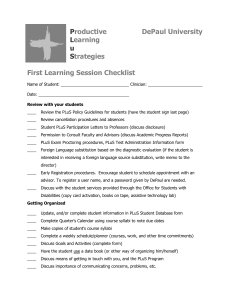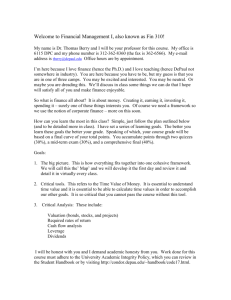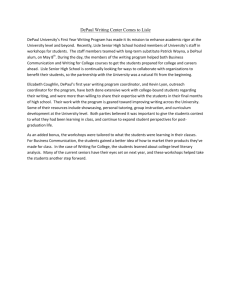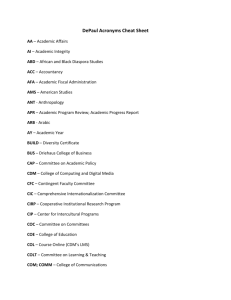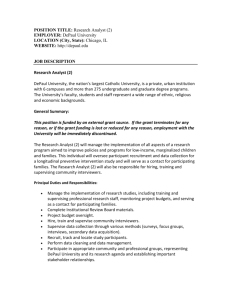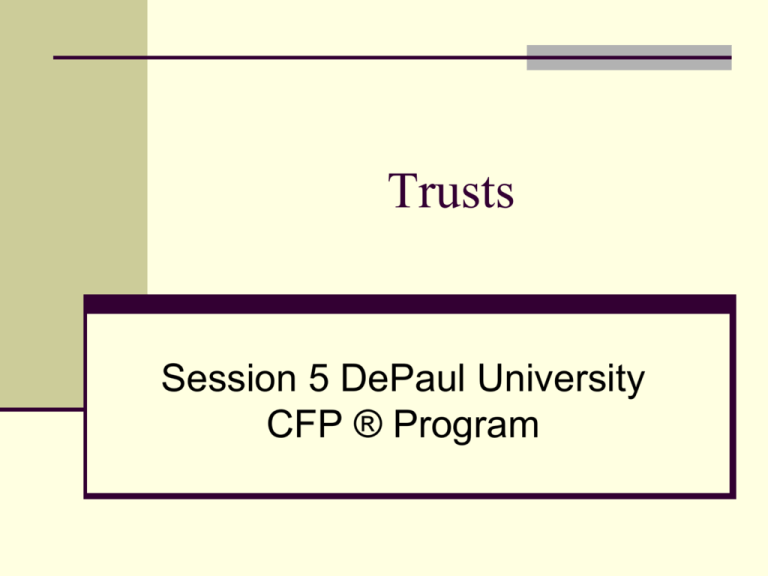
Trusts
Session 5 DePaul University
CFP ® Program
Trust Basics
A trust is an agreement under which money or
other property is held and managed by one
person for the current or ultimate benefit of
another.
Different types of trusts may be created to
accomplish specific goals.
Each kind may vary as to its degree of
flexibility and control by the transferor, trustee,
or both.
DePaul University All rights reserved.
2
The Purpose of a Trust
Trusts may be set up for a number of reasons,
for example:
to control and protect family assets both before
and after death
to manage the financial affairs of a minor
to mange the affairs of an incapacitated or
incompetent individual
to achieve gift and estate tax savings
DePaul University All rights reserved.
3
Elements of a Trust
Traditionally, three elements are necessary for a valid
trust:
The intent to create a trust
It then follows that there is a trust creator (also
called “trustor," "donor" or "settlor“) who has this
intent
The subject matter, or property (also called
“principal,” “corpus,” or “res”) that is subject to the trust
The object(s) or beneficiary(ies) of the trust.
Practically speaking, there must also be a trustee but
the common law rules did not require a trustee to be
named for a trust to exist.
DePaul University All rights reserved.
4
Elements of a Trust (continued)
Recall that the trustee holds legal title to the trust property and is
responsible for managing the trust principal.
The trustor can serve as trustee but watch for tax traps.
Two or more trustees may serve together,
The trustee may be an individual, an organization, or both
acting as co-trustees.
Recall that the beneficiary holds the equitable/beneficial interest
in the trust.
any person or entity may be a beneficiary, including
individuals, corporations, associations or units of
government.
Benefits may include principal and/or income
Beneficiary need not be competent
Trustor must be competent to create trust
Trustee must always be competent
DePaul University All rights reserved.
5
Question 5-1
Which of the following parties to a trust need be
competent only at the trust’s inception?
A. The trustee
B. The grantor
C. The beneficiary
D. The executor
DePaul University All rights reserved.
6
Trustee Responsibilities
Carry out the express terms of the trust instrument
Prudently invest trust assets
Be impartial among beneficiaries
Administer in the best interest of the beneficiaries
Account for actions and keep beneficiaries informed
Be loyal
Defend the trust
Generally, a trustee must not delegate, profit, self-
deal with trust property, or otherwise be in a conflict
of interest position
DePaul University All rights reserved.
7
What Happens If A Beneficiary
Dies?
When a beneficiary dies, residuary transfers
from wills and trusts can be structured in
various ways:
Per stirpes
Per capita
With per capita, look for the class:
“my children”
“my descendants”
“by generation”
DePaul University All rights reserved.
8
Per Stirpes Distribution
Per stirpes means taking “by representation” or “by
class.”
If beneficiaries are to share in a distribution per
stirpes, then the living members in the class of
beneficiaries closest in relationship to the transferor will
each receive an equal share.
If a member of that same class is deceased and
survived by any descendants, then their descendants
will take their share “by representation.”
DePaul University All rights reserved.
9
Per Stirpes Example
Sam has 4 children, A, B, C and D.
A predeceased Sam leaving no children
B predeceased Sam leaving 2 children, B1 and B2
C is living and has 8 children
D is living and has no children.
A testamentary gift by Sam stipulating a per stirpes
distribution yields this division:
A = 0.00%
B2 = 16.67%
B = 0.00%
C = 33.33%
B1 = 16.67%
D = 33.33%
DePaul University All rights reserved.
10
Per Capita Distribution
“Per capita,” means taking “by the head” or “by total
number of individuals.” If the beneficiaries are to share
in a distribution “per capita,” then all of the living
members of the identified class receive an equal share.
No share is created for a deceased class member.
Shares of surviving class members increase
proportionately
DePaul University All rights reserved.
11
Per Capita Example
Sam
has 4 children, A, B, C and D.
A predeceased Sam leaving no children
B predeceased Sam leaving 2 children, B1 and B2
C is living and has 8 children
D is living and has no children.
A testamentary gift by Sam stipulating a “per capita to
my children” distribution yields this division:
A = 0.00%
B2 = 0.00%
B = 0.00%
C = 50.00%
B1 = 0.00%
D = 50.00%
DePaul University All rights reserved.
12
Per Capita Example
Sam
has 4 children, A, B, C and D.
A predeceased Sam leaving no children
B predeceased Sam leaving 2 children, B1 and B2
C is living and has 8 children
D is living and has no children.
A testamentary gift by Sam stipulating a “per capita to
my descendants” distribution yields this division:
A = 0.00%
B2 = 25.00%
B = 0.00%
C = 25.00%
B1 = 25.00%
D = 25.00%
DePaul University All rights reserved.
13
Question 5-2
Mr. Black arranged that his two sons, Jack and Mack
inherit his $4 million estate in trust. Jack has two
children, Mindy and Cindy. Under Mr. Black’s per
capita arrangement , if Jack dies before his father, how
much would Cindy receive?
A. $-0B. $1 million
C. $2 million
D. $4 million
DePaul University All rights reserved.
14
Per Capita At Each Generation
Under the per capita at each generation
distribution the estate or trust property is
divided just as in per stirpes, but each share
passing to the next generation is divided
equally among all members of that generation
(not just the lineal descendants of deceased).
“Equally near, equally dear”
DePaul University All rights reserved.
15
Trust Property
Trust property may consist of real or personal
property
Trust property may also include a future
interest such as the right to receive proceeds
under a life-insurance policy
Property is made subject to the trust by
transfer to the trustee, commonly called a "gift
in trust."
DePaul University All rights reserved.
16
The Trust Agreement
The trust agreement, also called a “declaration of trust,”
is a legal document describing the terms and conditions
of the trust property will be managed, as well as how
and when the beneficiaries will enjoy their interest.
Legally speaking, it is not a contract, and separate
laws apply.
Most states have statutory provisions governing trust
administration – some may be superseded by the
trust agreement, others may not.
DePaul University All rights reserved.
17
Inter Vivos Trusts
Inter vivos trusts are created during the trustor’s
lifetime.
Proper drafting can shift the income tax liability from
the grantor to a beneficiary
Income earned by a trust established for a
dependent beneficiary may be taxed at the
parent's tax rate by the kiddie tax.
Transfer an irrevocable inter vivos trust may also
trigger gift tax consequences.
DePaul University All rights reserved.
18
Revocable vs. Irrevocable
Inter Vivos Trusts
Inter vivos trusts can be "revocable" or "irrevocable."
If revocable, the trustor may change the terms or
cancel the trust, resuming outright ownership of the
trust property.
If irrevocable, the trust terms become virtually
permanent.
The trust instrument should be explicit regarding
revocability or irrevocability.
The presumption of irrevocability varies by state.
In Illinois, the presumption is “irrevocable.”
DePaul University All rights reserved.
19
Irrevocable Inter Vivos Trusts
An irrevocable inter vivos trust may not be altered or
terminated by the trustor. There are two distinct
advantages of irrevocable trusts:
Income from trust property may be not taxable to the
trustor; and
The trust property and any post gift appreciation may
escape inclusion in the trustor's gross estate.
However, these benefits will be lost if the trustor is
entitled to:
receive any income
use the trust assets
otherwise control the administration of the trust
DePaul University All rights reserved.
20
The Revocable Inter Vivos Trust
The Revocable Living Trust or, simply, a “Living Trust,”
is a legal entity created by a trustor to hold and own
that grantor’s assets.
The Living Trust is an estate planning vehicle that
provides:
Privacy
Probate Avoidance
Continuity of financial management
Trustee is often but not necessarily the trustor
DePaul University All rights reserved.
21
Question 5-3
The initial trustee of a living revocable trust is
most often:
A. The trustor
B. A bank
C. A relative
D. An attorney
DePaul University All rights reserved.
22
Revocable Living Trusts
In general, a living trust provides the trustor with
complete control while competent. With a living trust,
the grantor may:
Add to or withdraw assets from the trust during lifetime;
Change the terms of the trust
Retain the right to make the trust irrevocable
The assets titled in the name of the living trust will
generally be includable in the trustor's gross estate,
but will generally avoid probate.
DePaul University All rights reserved.
23
Revocable Living Trusts
While the Grantor is Living
While the grantor is alive and well, the trust
allows the grantor to manage, invest, and spend
the trust assets for his or her own benefit.
If the grantor is serving as trustee, the
grantor uses his/her own SSN as the TIN for the
trust and reports income, deductions and credit
on Form 1040.
A third party trustee must obtain a TIN for the
trust and file Form 1041.
DePaul University All rights reserved.
24
Revocable Living Trusts When the
Grantor Becomes Incapacitated
The trust agreement typically specifies:
The criteria for determining grantor incapacity
One or more procedures to be followed if the grantor
becomes mentally incapacitated.
If the grantor is determined to be incapacitated and can
no longer serve as Trustee, the successor trustee
named in the trust agreement assumes the
management and investment of the trust property for
the grantor’s benefit.
No transfer of title is necessary.
DePaul University All rights reserved.
25
When the Revocable Living Trust
Grantor Dies
When the grantor/trustee dies, the successor
trustee assumes control.
Pays grantor's final bills, debts, and taxes.
Distributes the trust property as directed in
the trust agreement.
If there is no probate (and thus no executor)
the successor trustee will be responsible for
filing the Form 706 if required and making any
appropriate tax elections.
DePaul University All rights reserved.
26
Question 5-4
After Alex dies, his revocable living trust:
A. Would automatically be subject to probate.
B. May continue as an irrevocable trust
C. Pours over onto his will
D. Is required to end immediately.
DePaul University All rights reserved.
27
Living Trusts Avoid Probate
Although ignored for tax purposes, the living
trust is a valid entity under state law. Therefore,
even though the grantor dies, the trust “lives”
on.
Assets titled in the name of the grantor are
subject to probate.
Assets titled in the name of the trust avoid
probate.
DePaul University All rights reserved.
28
Testamentary Trusts
A trust created at death under a Will is called a
"testamentary trust.“ The term is also used for
trusts created under a living trust at the
grantor’s death.
A testamentary trust only arises after the
testator's death, when the Will becomes
effective.
A trust so created will not be valid until the Will
is admitted to probate.
DePaul University All rights reserved.
29
Funding Testamentary Trusts
The Will directs the distribution of part or all of
the decedent's estate to a trustee who:
is named under the Will
is charged with administering and distributing
the trust property according to the provisions of
the trust created under the Will.
DePaul University All rights reserved.
30
Probate and the Testamentary Trust
Before the trust property is used to fund the
testamentary trust, it normally passes through
the decedent's estate, subject to probate.
The trust itself does not go through probate.
Assets used to fund a testamentary trust are
potentially subject to estate and generationskipping transfer tax (GSTT).
DePaul University All rights reserved.
31
Question 5-5
Which of the following is least likely to go
through the probate process?
A. Harry’s car owned fee simple.
B. Barry’s testamentary trust.
C. Larry’s portion of a fishing cabin owned TIC
with his brother.
D. Garry’s one half of Washington community
property.
DePaul University All rights reserved.
32
Testamentary Trust Flexibility
A will, and any testamentary trust created
thereunder, may be revoked or amended at any
time prior to death.
Revisions can be made by:
Executing a new will
Executing a codicil (same requirements for
valid execution as a Will)
Upon death the Will, and thus the
testamentary trust, becomes irrevocable
DePaul University All rights reserved.
33
Pour-over Will
Good practice requires a grantor to execute a
"pour-over" will simultaneously with creation of a
living trust.
It operates as a safety net for any asset not titled
in the name of the trust
Avoids intestate administration
Guarantees all assets are subject to the same
plan.
Trust should be established before any Will
directs transfers to it.
DePaul University All rights reserved.
34
Simple versus Complex Trusts
Federal income tax law distinguishes between
complex and simple trusts.
In a simple trust, the trustee:
Is required to distribute all income currently, and
Is not authorized to make charitable gifts, and
Does not distribute principal
A complex trust generally may:
Accumulate income, and
Make charitable gifts
Distribute principal to beneficiary(s)
DePaul University All rights reserved.
35
Fiduciary Income Taxation
Like individuals, partnerships, and corporations,
estates and trusts may earn income that is
subject to income tax.
Fiduciary entities required to file Form 1041, U.S.
Income Tax Return for Estates and Trusts.
an estate with more than $600 of income
a simple trust having more than $300 in income
a complex trust having more than $100 in income
DePaul University All rights reserved.
36
Who Pays the Tax on
Trust Income?
Tax on trust income may be the obligation of:
The grantor
The beneficiary
The trust itself
Given compressed trust rates, the trust is
generally the least desirable taxpayer.
DePaul University All rights reserved.
37
Character of the Distributable Income
The distributable net income (“DNI”) retains its
character as it is distributed to the beneficiary.
Each beneficiary takes a pro-rata share of that
“flavor” of income.
Example: In 2012, a trust receives $20,000
tax-exempt municipal bond interest and
$10,000 of dividends. Any distribution will be
received by a beneficiary as 2/3 muni-bond
interest and 1/3 dividend.
DePaul University All rights reserved.
38
Taxation of Simple Trusts
For tax purposes, a simple trust is a conduit –
the beneficiary(s) pay tax on the income.
Rule applies whether or not income is
actually distributed
Trust pays tax on principal transactions (i.e.,
capital gains)
Watch for possible kiddie tax impact where
beneficiary is a dependent.
DePaul University All rights reserved.
39
Question 5-6
Tony set up a simple trust under which all trust
income is paid to his daughter, Ruth. Tony’s
brother, Chris is trustee of the trust. To whom,
if anyone, would the trust income be taxed?
A. Tony
B. The trust
C. Ruth
D. Trust income is generally not taxable
DePaul University All rights reserved.
40
Taxation of Complex Trusts
A complex trust tax pays tax on all undistributed
income (at severely compressed rates)
A deduction is available for distributions to
beneficiaries.
All distributions carry out DNI (no double tax)
Trustee may “throw back” distributions made
in first 65 days of calendar year, to previous
year
DePaul University All rights reserved.
41
When Is a Trust a
Tax-Paying Entity?
The trust is irrevocable and not otherwise
subject to the grantor trust rules
Income is accumulated per trust terms or
trustee’s discretion, or
Capital gain is incurred
DePaul University All rights reserved.
42
2012
Estate/Trust Income Tax Rates
Estates and Trusts
If Taxable Income Is:
The Tax Is:
Not over $2,400
15% of the taxable income
Over $2,400 but not over
$5,600
Over $5,600 but not over
$8,500
Over $8,500 but not over
$11,650
Over $11,650
$360 plus 25% of the excess
over $2,400
$1,160 plus 28% of the excess
over $5,600
$1,972 plus 33% of the excess
over $8,500
$3,011.50 plus 35% of the
excess over $11,650
DePaul University All rights reserved.
43
Grantor Trust Taxation
Trust income will be taxed to the grantor
personally if that grantor retains benefits from,
or power over, the trust.
Since personal tax rates are less compressed
than trust tax rates, this may desirable.
DePaul University All rights reserved.
44
What Makes Trust Income Taxable
to the Grantor?
When will trust income be taxable to its grantor?
When the trust is revocable
When the grantor/spouse does/may receive its
income.
When trust income does/may pay premiums on
life insurance policies where grantor/spouse are
named insured(s)
i.e a funded life insurance trust
When trust income is used to discharge the
grantor’s legal or support obligation
DePaul University All rights reserved.
45
What Makes Trust Income Taxable
to the Grantor?
Grantor taxed (continued)
When the grantor controls the beneficial
enjoyment of the trust
Distribution timing and amounts
When the grantor holds >5% reversionary interest
in the trust
When grantor controls certain investment powers
including power to vote the stock held by the trust
Note, the power to dismiss or change the
trustee does not taint the trust for income tax
purposes.
DePaul University All rights reserved.
46
Trusts Where the Grantor Retains
“Income”
A grantor may retained an interest in trust
income under one of several common
arrangements:
Grantor retained annuity trust (GRAT)
Grantor retained unit trust (GRUT)
Grantor retained income trust (GRIT)
Where a charitable intent exists the grantor
could create a charitable remainder annuity
or unitrust (CRAT or CRUT)
DePaul University All rights reserved.
47
Grantor Retained Annuity Trust
(GRAT)
A GRAT is an irrevocable trust which
guarantees the grantor a fixed amount annually
for a certain term.
The annuity must be paid regardless of trust
income earned.
Creating an irrevocable trust will trigger gift
tax consequences to grantor.
Cannot make gift to self
Gift is NPV of remainder interest
DePaul University All rights reserved.
48
Question 5-7
Liza established a $1 million 5% GRAT.
However, due to the recession, the trust
principal only earned 3% in the current year.
How much will Liza receive this year?
A. $100,000
B. $50,000
C. $30,000
D. Nothing until the trust earns its specified
percentage
DePaul University All rights reserved.
49
Determining the GRAT Term
A GRAT can be created for any term desired.
The longer the trust term the smaller the gift
of the remainder because the grantor’s
interest is greater.
When choosing a term consider that death of
the grantor during the GRAT term results in
gross estate inclusion of the FMV of the trust
at date of death.
DePaul University All rights reserved.
50
Short Term GRATs
Short term GRATs are used to lessen the
probability that the grantor will die during the
GRAT term.
A short term, coupled with a high annuity
payout can yield a remainder interest with
little or no value.
Result: reduction or elimination of the taxable
gift.
DePaul University All rights reserved.
51
Zeroed Out GRAT Example
Ed transfers property worth $1 million to a GRAT that
will pay him $129,500 per year for a term of 10 years at
the end of which the GRAT will terminate and the
property will be distributed to Ed’s children.
Assuming the applicable federal rate (“AFR”) was
5.0% at the time the GRAT was created, the value of
Ed’s retained annuity will be roughly $1 million (i.e.,
the GRAT is "zeroed out".)
In this case, the creation of the GRAT does not
involve a taxable gift.
DePaul University All rights reserved.
52
GRAT: Dying During the Term
Example
Assume Libby transfers assets worth $1,000,000 to a
GRAT retaining the right to receive an annuity of
$100,000 per year for the lesser of 10 years or her
remaining lifetime. In the third month of the ninth year of
the GRAT, Libby dies, while the trust corpus has a
value of $2,000,000 and the section 7520 rate is 10%.
$1,000,000 would be included in Libby’s gross estate
because it is the amount of corpus required to be
invested at 10% to generate income equal to the
$100,000 annuity.
DePaul University All rights reserved.
53
Grantor Retained Unitrusts
The grantor receives an annual payment
equal to a fixed percentage multiplied by the
FMV of the GRUT.
GRUT revalued annually to determine current
year payout
When asset values increase, so does payout
DePaul University All rights reserved.
54
Question 5-8
Why would transferring rental real estate to a
GRUT be a disadvantage to transferring rental
real estate to a GRUT?
A. Inflation protection would never be available.
B. The grantor would give up the income.
C. Annual revaluation of the trust property
could be costly.
D. The retained interest must be valued at zero.
DePaul University All rights reserved.
55
Qualified Personal Residence Trust
(QPRT)
A qualified personal residence trust (QPRT)
owns the grantor’s a personal residence for a
term of years.
Like a GRAT, the donor must outlive the
trust's term to avoid estate tax inclusion.
Length of grantor’s use term determines gift
value of transfer (longer term = smaller gift).
DePaul University All rights reserved.
56
QPRT Example
Claude, age 60, transfers his personal residence with a
value of $1,000,000 into a QPRT on October 1, 20XX
(when the section 7520 rate for purposes of valuing the
interest retained by the grantor was 7.2%), retaining a
term of 10 years and a contingent reversion.
The value of Claude’s retained interest and contingent reversion
is $583,770 and the value of the remainder interest is $416,230.
If Claude survives the 10-year term, the residence is out of his
estate.
Result: $1 million transferred (not including appreciation) at a
federal gift tax value of $416,230.
Transfer tax savings of using the QPRT over transferring the
residence at death could exceed $500,000.
DePaul University All rights reserved.
57
QPRTS vs GRATs
QPRT permits use of residence during term. Unlike
a GRAT the QPRT makes no distributions.
If donor survives the term and desires to continue
living in the residence, the donor must pay fair
market rent to the trust.
A QPRT permits future appreciation to escape
taxation in the donor's estate.
QPRT property located in another state will also
avoid ancillary probate.
DePaul University All rights reserved.
58
The Problem
With Grantor Retained Income Trusts
(GRITs)
Using a family GRIT, a grantor would transfer assets to
a trust, retaining the income a term with the remainder
going to a beneficiary.
Pre-1990, the NPV of the remainder interest gift was
reduced by the retained income interest.
Post-1990, the Chapter 14 zero valuation rules fix the
value of the retained interest at zero, thus the gift is
the FMV of the transferred asset.
The current gift tax impact makes this vehicle
relatively unattractive.
DePaul University All rights reserved.
59
Crummey Trusts/Provisions
Crummey trusts (or Crummey provisions found within
trusts) make otherwise future interest gifts eligible for
the annual gift tax exclusion by creating a limited
present interest in such additions.
The beneficiary is given the temporary right to
withdraw an amount equal to the lesser of:
The amount of the annual gift tax exclusion, or
The amount of the annual addition
Pro rata, if multiple beneficiaries
A Crummey provision is most commonly found in
irrevocable life insurance trusts (ILITs)
DePaul University All rights reserved.
60
Crummey Trust Example
The Parkers set up an irrevocable trust for their three children.
Each year they each give $13,000 per child to the trust, or $78,000
per year.
After each gift the trustee send written notice to each child
informing him of his right, for 30 days, to notify the trustee and
withdraw the addition.
If the right is not exercised within 30 days, then it expires.
The trustee can use assets of the trust for each child's benefit.
Assets left in the trust go to the child at age 35.
Over a 10 year period the parents can give $78,000 per year, or
a total of $780,000 to the trust. The total transfer tax savings
may be as high as $273,000 (per top 35% transfer tax bracket).
DePaul University All rights reserved.
61
Spendthrift Trust
Spendthrift trusts typically contain a provision
prohibiting the beneficiary’s creditors from seizing trust
assets to satisfy the beneficiary's debts.
Almost every trust contains such a provision
Spendthrift trusts are legal in most states
Useful when the grantor considers a beneficiary to be
irresponsible about money.
The trustee controls the trust income, distributing
money to the beneficiary as needed
Trustee may pay beneficiary’s creditors directly;
bypassing the beneficiary completely.
DePaul University All rights reserved.
62
Bypass Trust /”B” Trust
The bypass trust (also known as the “B” trust and credit
shelter trust) is usually established at death to hold
property equal to the exemption equivalent of the estate
tax credit ($5,120,000 in 2012).
Family trust (rather than marital trust) to keep
property out of the surviving spouse’s estate
The “bypass” is of the survivor’s estate
Although survivor spouse may have B trust income
(with or without other beneficiary(s), and/or serve as
trustee, survivor spouse is not the estate tax owner.
DePaul University All rights reserved.
63
Question 5-9
The purpose of the typical “B” trust is to:
A. Maximize the use of the marital deduction.
B. Shelter income for Medicaid recipients
C. Split gifts in trust.
D. Shelter the exemption equivalent of the
unified credit.
DePaul University All rights reserved.
64
Marital Trust/”A” Trust
The marital trust is established to hold property passing
to the surviving spouse and qualify for the marital
deduction. Spouse typically entitled to all income.
Surviving spouse’s interest is not terminable.
Spouse given a general power of appointment
Alternatively, an estate trust which distributes to the
surviving spouse’s estate will qualify for the marital
deduction
Trust A property is included in the survivor’s gross
estate
DePaul University All rights reserved.
65
Qualified Terminable Interest Property
Trust /”C” Trust
The QTIP trust (also known as a “C” trust, or
current income trust) is a marital trust providing
the survivor spouse with income for life but with
no control over the ultimate disposition of the
trust principal (terminable interest).
Property transferred to the trust qualifies for
marital deduction
Statutory exception to terminable interest rule
DePaul University All rights reserved.
66
QTIP Trust Requirements
QTIP election must be made by executor on Form
706
Surviving spouse must have the right to receive
mandatory payment of trust income, at least annually,
for life.
Trust must prohibit the assignment or distribution of
either principal or interest to anyone other than the
surviving spouse
Spouse may have rights to principal for health,
education, maintenance and support
DePaul University All rights reserved.
67
QTIP Trust Example
Dad, who has grown children from his marriage to Mom,
marries Trixie. His objectives are 1.) provide a
comfortable lifestyle to Trixie as long as she lives, 2.)
obtain an estate tax marital deduction, and 3.) leave the
principal to his children when Trixie dies.
Dad’s executor establishes QTIP trust per Dad’s will
instruction and makes the election
Trixie gets all income for life
No distributions to anyone other than Trixie
Upon Trixie’s death:
QTIP property is included in Trixie’s gross estate
Trust principal passes to Dad’s children.
DePaul University All rights reserved.
68
Question 5-10
What is the typical income distribution
arrangement associated with a QTIP trust?
A. Income is distributed to the grantor’s
widow/er.
B. Income is distributed to the grantor’s
children.
C. Income is shared among the grantor’s
widow/er and children.
D. Income is accumulated in the trust.
DePaul University All rights reserved.
69
Trusts for Children: 2503(c) Trust
Statutory exception to the present interest rule
The first $13,000 transfer each year to a 2503(c)
trust is eligible for the annual gift tax exclusion
Minor generally receives no distribution from the
trust but must have the right to withdraw all trust
assets at age 21
Income may be accumulated in the trust or
expended to benefit the minor
Accumulated income (typical) taxed at trust rates
If beneficiary dies before age 21, assets pass to
child’s estate
DePaul University All rights reserved.
70
2503(c) Trust Example
Lowell sets up a 2503(c) trust naming his 9-year
old daughter, Louella as beneficiary. Lowell
names himself as trustee.
If Lowell dies before distribution of trust
assets to Louella, the FMV of the trust assets
is included in Lowell’s gross estate.
Solution: Lowell should name an adult other
than himself (the grantor) as custodian
DePaul University All rights reserved.
71
Section 2503(b) Trust
The Section 2503(b) trust is generally used to
benefit adult children so that a trustee can control
when the child receives distributions of principal.
Mandatory income distribution is required.
Gifts to trust have two parts – income and
remainder
Value of income determined under §7520 Tables
The first $13,000 of income portion of gift
qualifies for the annual gift exclusion.
Unlike 2503(c), no required termination date
DePaul University All rights reserved.
72
Question 5-10
Which of the following trusts must operate as a
simple trust?
A. A special needs trust
B. A 2503(c) trust
C. A living revocable trust
D. A 2503(b) trust
DePaul University All rights reserved.
73
Special Needs Trusts
A Special (Supplemental) Needs Trust enables a
physically or mentally disabled individual, or an
individual with a chronic or acquired illness, to have,
held in Trust for his or her benefit, an unlimited
amount of assets.
In a properly-drafted Supplemental Needs Trust,
those assets are not considered countable assets for
purposes of qualification for certain governmental
benefits.
DePaul University All rights reserved.
74
Special Needs Trusts
(continued)
Such benefits may include Supplemental Security
Income (SSI), Medicaid, vocational rehabilitation,
subsidized housing, and other benefits based upon
need. For purposes of a Supplemental Needs Trust,
an individual is generally considered impoverished if
his or her personal assets are less than $2,000.00.
A Supplemental Needs Trust provides for
supplemental and extra care over and above that
which the government provides.
DePaul University All rights reserved.
75
Uniform Gifts to Minors Act
In most states, minors do not have the right to
contract. The UGMA offers a simple way for a
minor to own financial assets including certain
securities.
UGMA is the law in only two states: Vermont
and South Carolina
The more modern UTMA has been adopted
by the balance of the states.
DePaul University All rights reserved.
76
Uniform Transfer to Minors Act
UTMA accounts enjoy greater investment
flexibility than do UGMA accounts.
UTMA accounts may hold real property
May hold intangible assets such as
copyrights and patents
UTMA accounts may be created at death
through a will
In most states, the custodian is required to
transfer UTMA assets when the beneficiary
attains age 21.
DePaul University All rights reserved.
77
Registering the Minor’s Account
In most states, minors accounts are as:
[ Name of Custodian ] as custodian for [ Name of
Minor ] under the Uniform Transfers to Minors Act - [
Name of State of Minor's residence ]
Example: Abe Lincoln, custodian for Tad Lincoln,
under the Illinois Uniform Transfers to Minors Act
The minor's SSN is the taxpayer ID for this account.
The custodian certifies the W-9 form.
Because the income is attributable to the minor,
kiddie tax rules apply
DePaul University All rights reserved.
78
Question 5-12
Which is a potential advantage to an UTMA
account?
A. The kiddie tax
B. Distribution at a specified age
C. Investment control
D. Assured removal of transferred assets from
donor’s estate.
DePaul University All rights reserved.
79
Death of Custodian and Minor
If a donor also serving as custodian dies
before UGMA/UTMA assets are distributed to
the beneficiary, such assets must be included
in the custodian’s estate (right to determine
beneficial enjoyment).
If custodian not the donor, assets included in
the beneficiary’s estate if the minor dies
before the property is distributed (at majority)
DePaul University All rights reserved.
80
Totten Trusts
A Totten trust is today more commonly known
as a POD (pay on death) designation for bank
accounts.
Called TOD (transfer on death) for brokerage
accounts
Not a true trust; more akin to a revocable
survivorship
Does avoid probate
DePaul University All rights reserved.
81
Miller Trusts
A "Miller" Trust (also called Income Only Trust) has only
one purpose: to qualify a Medicaid applicant with
income in excess of the eligibility limit for long-term care
assistance from Medicaid.
The income in excess of the eligibility criteria is
placed in the trust with a third party trustee.
Generally, the applicant will be allowed to retain
$35 per month of the income
May be possible to divert some of the income to
the spouse and pay a fixed amount towards his
patient's responsibility for nursing home care.
DePaul University All rights reserved.
82

